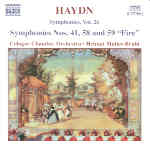While Volume 26 of Naxos’ continuing series of Haydn symphonies centers firmly in the composer’s so-called “Stürm und Drang” period, these major-key works are neither stormy nor stressful, not even all that turbulent. Nonetheless they do allude to Haydn’s ongoing “restless” investigation of the symphony’s potential, and they clearly foreshadow some of his best mature works in that form. The festive No. 41 clings to the jovial Italianate style of the time, employs trumpet and drums for heightened effect, and tosses in some tricky spots for solo flute in the Andante and for high horns in the Trio of the minuet. The latter pair of symphonies tilts more toward the unconventional: in No. 58 the irregular rhythms in the famous “limping” minuet, as well as quirky opening off-beats and daring harmonic changes (measures 45 and 146) in the finale, belie the work’s stolid classical veneer. Meanwhile, the sharp dynamic and mood contrasts of the “Fire” symphony’s first movement and bold horn statements in the finale (and, momentarily out of nowhere, in the Andante) speak to Haydn’s enduring originality and gift for surprise.
Once again, Naxos turns to Helmut Müller-Brühl and the Cologne Chamber Orchestra, a worthy member of the triumvirate tackling this cycle, with good results. For those keeping track, the Cologne players use modern instruments but play in “period-style”–which in general means clean, crisp textures, minimal string vibrato, incisive timpani, quick tempos, clipped phrase endings, hair-pin dynamic turns on extended notes, harpsichord continuo, and (somewhat) faithful observance of repeats.
But, as with his other traversals of these symphonies, Müller-Brühl doesn’t add much in the way of inflection or character. Compare, for example, Müller-Brühl’s deadpan account with Franz Brüggen’s (Philips), in which Brüggen uses all those unmarked sforzandos to bring out the eccentric elements of No. 58’s minuet. Sure, Müller-Brühl gets all the notes right, and for purists that may make him more respectable–but it doesn’t sharpen his reading’s rather dull edge. At bottom, this disc is a well-executed, acceptable companion to the catalog (both Naxos’ and the general Haydn discography) that will arouse neither zeal nor derision. And, at the very least, it keeps the Haydn spirit alive in the face of severely diminished releases of these lesser-known works.
































